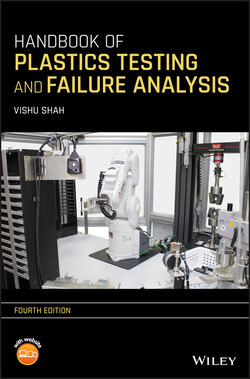Читать книгу Handbook of Plastics Testing and Failure Analysis - Vishu Shah - Страница 9
PREFACE TO THE FOURTH EDITION
ОглавлениеPlastics testing technology, like all other evolving technologies, is dynamic in its principle. Even the well‐established tests get continual refinement. The advent of computers, robotics, and other advanced manufacturing technologies has contributed to the simplicity, accuracy, automation, and speed of testing. A lot has evolved since the third edition. Notable and dramatic changes have taken place in test equipment. They are in response to the demand from the material suppliers, compounders, processors, manufacturers, and end‐users. The explosive growth of the plastics industry has left a void in terms of recruiting trained technicians to conduct the tests in a meaningful way. The equipment suppliers have developed comprehensive technology that includes more sophisticated equipment that is capable of performing tests without much intervention and also analyze the data and present results in an easy‐to‐interpret format.
Accordingly, the fourth edition seeks to update the chapters in line with the latest developments that include the revisions to the testing procedures, photographs showing the newer version of commercially available equipment, useful data, and references. The appendix section has been revised extensively. The evolution of science and technology‐based search engines has made finding the listing of standards and comparing property values relatively more straightforward, thus eliminating the need for the printed version. Appendix pointing the readers to information sources on the web along with the Links to Recommended open source for quick learning is added.
Included with the third edition was a DVD containing numerous color photographs, depicting photoelastic analysis, color theory, and animations along with a virtual tour of the plastics testing laboratory. This has been moved to online access with the latest revisions. In line with the primary objective of this book of providing a hands‐on reference for the novice and professionals, a new feature is added. The readers will have access to the supplementary website containing color photographs, animations, videos, and a problem‐solution manual.
Once again, I wish to express thanks to all the users of previous editions for their constructive comments and helpful suggestions for changes and improvements for the next edition and to those who helped with this revision. In particular, I wish to thank Rich Goshgarian, Francesca Pinto of Instron Corporation, Al Zielnik of Atlas Material Testing, Jim Galipeau of Intertek, Mike Bradley of Thermo Fisher Scientific, Joel Feingold and Tim Wilson of Strainoptics, Inc., Patrick Burke of Jordi Labs, and Sandra Weixel of BYK‐Gardner. Many thanks to Dr. Todd Menna of Element Materials Technology for his invaluable contribution and all other companies for providing numerous illustrations and diagrams. Lastly, I would like to thank the publisher and the staff, especially Jonathan Rose and Aruna Pragasam, for guiding me and patiently waiting for me to complete the revision, which took much longer than anticipated.
I would be remiss if I did not by all rights thank my caring, loving, and supportive wife Charlene, my lovely daughter Beejal, and my son Neerav and his soul mate Hiral for their support and encouragement.
Vishu Shah
Consultek, LLCDiamond Bar, CA
